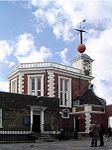Greenwich Castle
Castles in LondonFormer buildings and structures in the Royal Borough of GreenwichFormer castles in EnglandGreenwich ParkLondon building and structure stubs ... and 3 more
Royal residences in the Royal Borough of GreenwichRoyal residences in the United KingdomTudor royal palaces in England

Greenwich Castle was a hunting lodge used during the reign of Henry VIII, located in Greenwich Park, in Greenwich, England. The Royal Observatory, Greenwich now stands on the site. Greenwich Castle was apparently a favourite place for Henry VIII to house his mistresses, as it was within easy travelling distance of Greenwich Palace at the foot of the hill.The castle was previously known as Duke Humphrey's Tower after its builder, Humphrey, Duke of Gloucester, a younger brother of King Henry V.
Excerpt from the Wikipedia article Greenwich Castle (License: CC BY-SA 3.0, Authors, Images).Greenwich Castle
Duke Humphrey Road, London
Geographical coordinates (GPS) Address Website Nearby Places Show on map
Geographical coordinates (GPS)
| Latitude | Longitude |
|---|---|
| N 51.4779 ° | E -0.0019 ° |
Address
Greenwich Park
Duke Humphrey Road
SE10 8QY London (Royal Borough of Greenwich)
England, United Kingdom
Open on Google Maps










